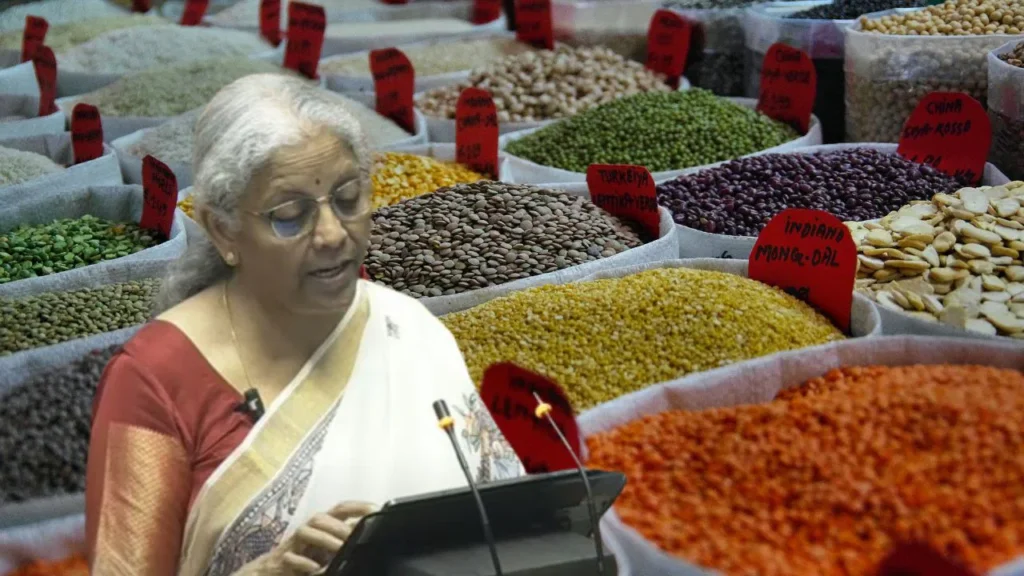
Why in News?
Finance Minister Nirmala Sitharaman introduced a six-year “Mission for Aatmanirbharta (Self-Reliance) in Pulses” during the Union Budget 2025-26. With an allocation of ₹1,000 crore, this initiative aims to achieve self-sufficiency in tur/arhar (pigeon pea), urad (black gram), and masoor (red lentil). The mission focuses on MSP-based procurement, post-harvest management, and technology-driven solutions for pulse farming.
This announcement comes at a time when India’s pulses imports are projected to reach an all-time high, exceeding $5.9 billion in 2024-25. This raises concerns about India’s strategy for self-sufficiency in pulses, especially given that near self-reliance was achieved just two years ago. The development is crucial for CLAT Current Affairs, as economic policies impact Constitutional Law for CLAT aspirants.
Introduction
Pulses are a vital protein source in the Indian diet and an essential part of agricultural production. Despite multiple government efforts, India continues to depend on imports. Between 2013-14 and 2016-17, pulses imports surged, reaching 58.41 lakh tonnes. However, between 2018-2021, imports declined significantly due to improved domestic production, nearing self-sufficiency.
Currently, with pulses imports rising again, policy interventions are needed to boost domestic production. The renewed Aatmanirbharta initiative is essential for food security, price stabilization, and reducing import dependency. This is a significant topic for CLAT GK 2026 and Law Entrance Updates.
India’s Pulses Imports & Production Trends
Pulses imports surged by 56.6%, reaching $3.82 billion (April-November 2024).
Imports for 2024-25 are projected at $5.9 billion, a record high.
2018-2021 saw near self-sufficiency, with reduced imports.
Rising demand and stagnant productivity in tur/arhar, urad, and masoor are driving increased import dependence.
Government’s ₹1,000 Crore Aatmanirbharta Mission in Pulses
Aims to achieve self-reliance in:
Tur/Arhar (Pigeon Pea)
Urad (Black Gram)
Masoor (Red Lentil)
Key components:
MSP-based procurement to support farmers.
Post-harvest management to reduce losses.
Technology-driven advancements to enhance yield and quality.
Implementation by NAFED & NCCF for efficient procurement.
Decline in Self-Sufficiency: Record Imports
2013-17: Imports surged from 51.83 lakh tonnes to 58.41 lakh tonnes.
2018-21: Self-sufficiency achieved, with imports declining to 24.61 lakh tonnes in 2020-21.
2023-24: Imports rose again, crossing 51.07 lakh tonnes due to falling domestic production.
Success Story of Peas (Matar) & Moong Dal
Government interventions improved moong dal & peas production.
Moong dal output grew from 9.56 lakh tonnes (2013-14) to 22.22 lakh tonnes (2021-22).
Short-duration moong dal varieties now allow farmers to cultivate twice a year.
Peas production is at a seven-year high, showing resilience.
Challenges in Achieving Self-Reliance
Long Growing Duration: Tur/arhar (170-240 days), Urad & Masoor (120-150 days), limiting crop cycles.
Competition with High-Yield Crops: Farmers prefer rice, wheat, & sugarcane for better returns.
Climate Risks: Pulses are rain-dependent & vulnerable to erratic monsoons.
Lack of Hybrid Seeds & Mechanization: Limited access to high-yielding seeds & mechanized farming.
Inefficient MSP Procurement: Delays in government procurement discourage farmers.
Policy Recommendations for Self-Sufficiency
Hybrid Seeds & Biotechnology: Develop high-yield, short-duration pulse varieties.
Expanded MSP & Procurement: Strengthen NAFED & NCCF networks; introduce direct farmer incentives.
Crop Diversification & Incentives: Promote pulse-cereal crop rotation & provide subsidies.
Climate Resilience: Invest in drought-resistant varieties & efficient irrigation.
Strengthening Value Chains: Enhance storage, processing, and private-sector investments.
Key Terms Explained
Aatmanirbharta (Self-Reliance): Policy to reduce import dependence & boost local production.
Minimum Support Price (MSP): Government-set price ensuring farmer income stability.
NAFED & NCCF: Agencies responsible for agricultural procurement & marketing.
Hybrid Seeds: Genetically improved seeds for better yields.
Climate Resilience: Farming techniques to withstand environmental changes.
Conclusion
The renewed Aatmanirbharta mission is a crucial step toward ensuring food security, price stability, and reducing import dependency. However, success will depend on:
Faster adoption of short-duration hybrid varieties.
Expanding MSP procurement for fair farmer compensation.
Encouraging climate-resilient agriculture.
Strengthening pulse processing & distribution networks.




